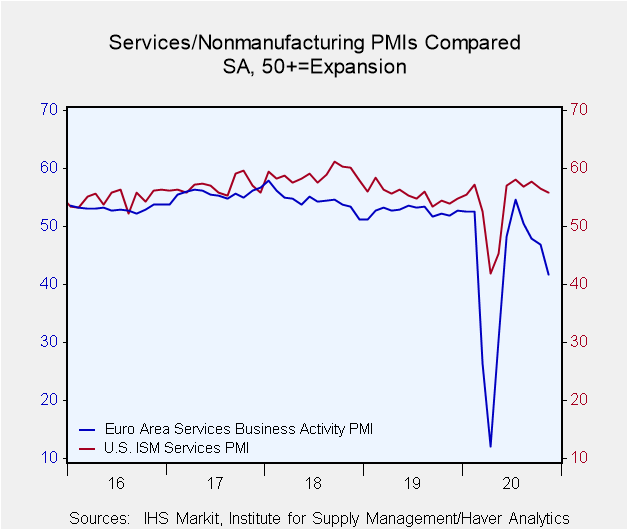 Global| Dec 03 2020
Global| Dec 03 2020Total PMIs Show the Impact of the Return of the Virus
Summary
When the virus goes viral Once again anti-virus policies have hammered the global economy. China is the only exception. The ranking column is the starkest reminder of how the service sector is pressured. Only China where the virus [...]
 When the virus goes viral
When the virus goes viral
Once again anti-virus policies have hammered the global economy. China is the only exception. The ranking column is the starkest reminder of how the service sector is pressured. Only China where the virus originated and where data are most suspect has a high-ranking service sector- at a 96.6 percentile standing. Elsewhere the highest services standing is in the United States (ISM) at a 40.7 percentile standing. The Markit surveys of the U.S. continue to give the U.S. much, much, higher readings, but I prefer the venerated ISM survey. Its message seems more in line with the facts on the ground in the U.S. For all of the EMU, the services standing is in its lower five percentile; the sector is this weak or weaker only about 5% of the time. In the U.S., the November results are so much better, but the virus outbreak in Los Angeles is now so bad there is now a blanket order for everyone to ‘stay at home.’ Who knows what the EU-U.S. comparison will look like next month?
Next?
In Europe, countries are lifting what have been some pretty stringent restrictions in November. The services PMI readings attest to the impact of those measures. Come December data there should be improving again. How much is still uncertain.
Manufacturing vs. Services
There is a sharp difference between services and manufacturing. However, the service sector metrics withered everywhere in Europe and in the U.S.; manufacturing followed suit except for an improvement on the month in the U.K. Basically, the impact of anti-virus measures took a toll on both sectors but took a much larger toll on services. The manufacturing rank standings are higher than for services in every case – and usually by a large measure.
Manufacturing is weathering the storm the best in China, the U.K., Germany, the U.S., and the EMU in that order (based on rank standings calculated on data since January 2016). The service sector is doing best in China with a 96.6 percentile standing followed by the U.S. at a 40.7 percentile standing and rankings elsewhere less than half the U.S. service sector ranking at best. The service sector numbers are pretty stark.
Aggregate demand ≠ Jobs
Earlier this week (yesterday), a report on unemployment rates showed how much better Europe had done in that regard than the U.S. That is odd since the U.S. service sector is performing so much better than in Europe and the service sector is the engine of employment. This difference highlights the differences in the way. Europe is dealing with the blowback effects from the virus and with virus shutdowns compared to the U.S. Europe is softening the blow on the labor market while the U.S. has only tried to shore up aggregate demand and has delivered spotty assistance to the unemployed who still encounter the myriad issues that unemployment brings to the table.
The age of vaccine, if you know what I mean
While there are vaccines out and the U.K. has already approved one for use and distribution, it will take to the end of the second or third quarters of 2021 to have seen enough inoculations to really corral the virus in those countries with the resources to act as fast as possible. Developing economics have had a pledge of inclusion from the G20 to not be left behind, but they clearly will lag. The future will now hang in the balance of virus policy and vaccine delivery. All of this is quite outside the purview of economics. But based on what we seem to be able to know, there are at least other 6 to 8 very tough months ahead even if the vaccines are rolled out in a ‘best case’ scenario.
Epilogue to a virus
Meanwhile, geopolitical risks still lurk and there is a changing at the helm of the U.S. economy set for January and that is causing new focus on U.S.-China policy both its economic and political aspects. Iran is pressuring to get back into the nuclear deal that Trump exited. There are U.S.-European trade issues to be settled and a great deal more. Possible a real end to the Brexit end game! The world remains a dangerous place with the virus disruption simply adding to the dangers with China’s extreme economic success looking more and more disturbing.
Robert Brusca
AuthorMore in Author Profile »Robert A. Brusca is Chief Economist of Fact and Opinion Economics, a consulting firm he founded in Manhattan. He has been an economist on Wall Street for over 25 years. He has visited central banking and large institutional clients in over 30 countries in his career as an economist. Mr. Brusca was a Divisional Research Chief at the Federal Reserve Bank of NY (Chief of the International Financial markets Division), a Fed Watcher at Irving Trust and Chief Economist at Nikko Securities International. He is widely quoted and appears in various media. Mr. Brusca holds an MA and Ph.D. in economics from Michigan State University and a BA in Economics from the University of Michigan. His research pursues his strong interests in non aligned policy economics as well as international economics. FAO Economics’ research targets investors to assist them in making better investment decisions in stocks, bonds and in a variety of international assets. The company does not manage money and has no conflicts in giving economic advice.






